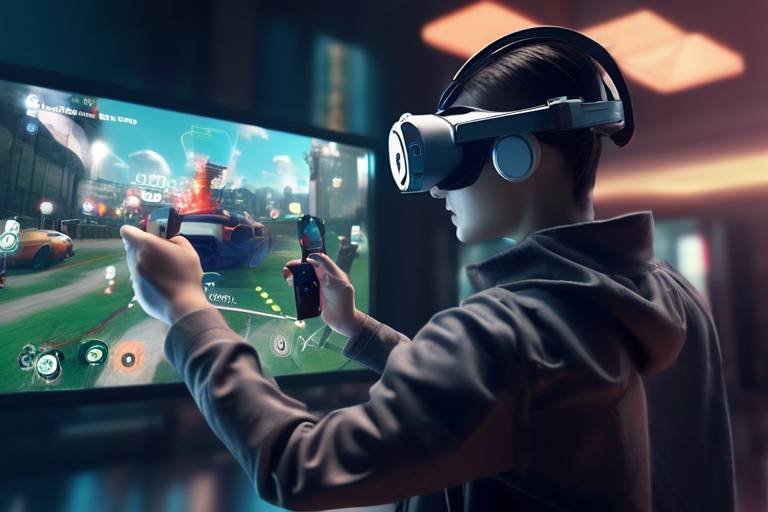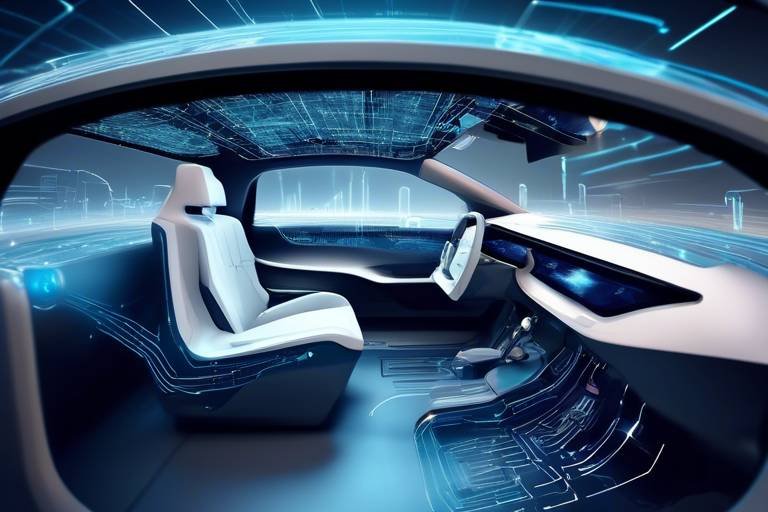Augmented Reality: The Future of AI in Gaming
As technology continues to evolve at a breathtaking pace, the gaming industry finds itself at the forefront of innovation, particularly with the integration of Augmented Reality (AR) and Artificial Intelligence (AI). Imagine a world where the boundaries between the digital and physical realms blur seamlessly, allowing players to interact with virtual elements as if they were part of their real environment. This is not just a dream; it's the reality that AR is bringing to the gaming landscape. In this article, we will explore how these two powerful technologies are revolutionizing the gaming experience, making it more immersive, engaging, and personalized than ever before.
From the early days of simple overlays to the sophisticated systems we see today, the evolution of AR technology in gaming has been nothing short of remarkable. Remember the excitement when Pokémon GO took the world by storm? That was just the tip of the iceberg. Today, AR games leverage advanced computer vision and sensor technology to create interactive experiences that respond to the player's movements and surroundings. This means that players can now engage with characters and environments that feel incredibly real, enhancing their overall gaming experience.
But what happens when we add AI into the mix? The integration of AI in AR games opens up a treasure trove of possibilities. AI can analyze player behavior, adapt gameplay, and even create unique narratives based on individual player preferences. Imagine playing a game where the storyline changes based on your decisions or where non-player characters (NPCs) learn from your actions. This level of interactivity not only keeps players engaged but also fosters a deeper emotional connection to the game. It’s like having a conversation with your favorite character, where they understand you and react accordingly!
The journey of AR in gaming can be traced back to humble beginnings, with early experiments focusing on simple overlays and basic interactions. However, the rapid advancement of technology has paved the way for more immersive experiences. Today, AR games utilize sophisticated hardware and software to create lifelike simulations that captivate players. The evolution of AR is marked by significant milestones, such as:
- 2000: The first AR game, "AR Quake," was developed, allowing players to experience a virtual world overlaid on their physical environment.
- 2016: Pokémon GO became a global phenomenon, demonstrating the potential of AR to engage players in real-world exploration.
- Present: Modern AR games incorporate AI to create dynamic environments and intelligent NPCs, providing a richer gaming experience.
As we look to the future, the combination of AR and AI promises to redefine how we play and interact with games. The potential for creating smart NPCs that respond to player actions, dynamic environments that evolve with gameplay, and personalized experiences tailored to individual preferences is just the beginning. The gaming industry is on the cusp of a revolution, and players are the ones who will benefit the most.
AI is the backbone of innovation in AR gaming. It enhances the experience by providing adaptive gameplay and enabling smarter interactions. For instance, AI algorithms can analyze player performance and adjust the game’s difficulty level in real-time, ensuring that the challenge remains just right. This adaptability keeps players engaged and prevents frustration, creating a more enjoyable experience overall.
One of the most exciting developments in AR gaming is the creation of smart NPCs. These characters are no longer mere background figures; they are designed to respond intelligently to player actions, making the environment feel alive. Imagine walking through a virtual city where the characters greet you, react to your choices, and even remember past interactions. This level of engagement transforms the gaming experience, making it feel more like a living, breathing world.
Another fascinating aspect of AI in AR gaming is procedural content generation. AI algorithms can create unique game content on the fly, allowing for endless gameplay experiences. This means players can explore new worlds, face different challenges, and encounter varied narratives each time they play. It’s like having an infinite universe of possibilities right at your fingertips!
AI's ability to adjust difficulty levels based on player performance is a game-changer. This feature ensures that players remain challenged without feeling overwhelmed. By analyzing how well a player is doing, the game can increase or decrease the difficulty, providing a balanced experience that keeps players coming back for more.
AI-driven features in AR games significantly boost player engagement. By offering personalized storytelling and tailored challenges, players find themselves more invested in the game. Imagine a game that remembers your choices and adapts accordingly, creating a unique narrative that resonates with you. This level of personalization can turn a simple gaming session into a memorable journey.
AR is not just about individual experiences; it also fosters social interactions among players. With the rise of multiplayer AR games, players can share experiences, collaborate on challenges, and build communities. This social aspect enhances the overall gaming experience, making it more enjoyable and engaging.
In multiplayer settings, AR allows players to interact seamlessly in shared virtual spaces. AI plays a crucial role in facilitating these interactions, ensuring that gameplay remains smooth and competitive. Whether you’re teaming up with friends or competing against others, the fusion of AR and AI creates exciting multiplayer experiences that keep players coming back for more.
AR games also encourage community formation, enabling players to connect, collaborate, and compete in immersive environments. These shared experiences foster a sense of belonging and camaraderie among players, transforming gaming into a social activity that transcends geographical boundaries.
- What is Augmented Reality in gaming?
Augmented Reality (AR) in gaming refers to the integration of digital elements into the real world, allowing players to interact with virtual objects and characters as if they were part of their physical environment. - How does AI enhance AR gaming?
AI enhances AR gaming by enabling smarter interactions, adaptive gameplay, and personalized experiences that respond to individual player preferences and behaviors. - What are smart NPCs?
Smart NPCs are non-player characters that respond intelligently to player actions, creating a more immersive and engaging gaming experience. - How does procedural content generation work?
Procedural content generation uses AI algorithms to create unique game content in real-time, providing players with endless gameplay experiences.

The Evolution of Augmented Reality in Gaming
Augmented Reality (AR) has come a long way since its inception, evolving from simple concepts into a powerful tool that reshapes how we experience gaming. The journey of AR in gaming can be traced back to the early 1990s when the term was first coined. Back then, the technology was rudimentary, and the idea of blending digital content with the real world was more of a dream than a reality. However, as technology advanced, so did the possibilities for AR in gaming, leading to groundbreaking innovations that have captivated players worldwide.
One of the earliest examples of AR in gaming was the 1992 game "Nightmare," which utilized a head-mounted display to create a primitive AR experience. Although it was limited by the technology of the time, it laid the groundwork for future developments. Fast forward to the 2000s, when mobile devices started to gain traction. The introduction of smartphones equipped with cameras and sensors opened the floodgates for AR gaming. Suddenly, developers could create games that allowed players to interact with their surroundings in entirely new ways.
With the launch of "Pokémon GO" in 2016, AR gaming reached a tipping point. This mobile game combined the thrill of catching virtual creatures with real-world exploration, leading to an explosion of popularity. Players found themselves wandering parks and streets, hunting for Pokémon, which created a communal experience that transcended the traditional gaming environment. The success of "Pokémon GO" demonstrated the potential of AR to not only enhance gameplay but also to foster social interactions among players.
Today, the evolution of AR in gaming continues at a rapid pace. Advanced technologies such as computer vision, depth tracking, and simultaneous localization and mapping (SLAM) have significantly improved the accuracy and immersion of AR experiences. For instance, games like "Harry Potter: Wizards Unite" and "Ingress" have built on the foundation laid by "Pokémon GO," offering players richer narratives and more complex interactions with their environment.
Moreover, the integration of AR with other technologies, particularly Artificial Intelligence (AI), is paving the way for even more innovative gaming experiences. AI can analyze player behavior and adapt the game environment in real-time, creating a personalized experience that feels unique to each player. This synergy between AR and AI is not just a trend; it's a glimpse into the future of gaming where the boundaries between the physical and digital worlds blur, creating a truly immersive experience.
In summary, the evolution of augmented reality in gaming has been a remarkable journey marked by technological advancements and creative innovations. From its humble beginnings to the current state of interactive and immersive experiences, AR has transformed the gaming landscape. As we look ahead, the potential for AR to redefine gaming continues to grow, promising exciting developments that will keep players engaged and eager for more.
- What is augmented reality (AR) in gaming? - AR in gaming refers to the integration of digital content with the real world, allowing players to interact with virtual elements superimposed on their physical surroundings.
- How has AR evolved over the years? - AR has evolved from basic concepts in the early 90s to sophisticated applications in mobile games, significantly enhanced by advancements in technology.
- What role does AI play in AR gaming? - AI enhances AR gaming by creating smarter interactions, adaptive gameplay, and personalized experiences, making games more engaging for players.

AI Integration in Augmented Reality Games
Imagine stepping into a world where the boundaries between reality and the digital realm blur seamlessly. That's what augmented reality (AR) brings to the gaming universe, and when you sprinkle in a little artificial intelligence (AI), the magic truly begins. AI integration in AR games isn’t just a trend; it’s a revolution that transforms how players interact with their environments and each other. By harnessing AI, developers can create experiences that adapt to individual players, making each session uniquely captivating.
One of the most exciting aspects of AI in AR gaming is its ability to enhance smart interactions. Picture this: you’re playing a game where the characters around you react to your every move, not just in scripted ways, but with genuine intelligence. This is achieved through advanced algorithms that allow non-player characters (NPCs) to learn from player behaviors, creating dynamic gameplay that feels alive. The world around you doesn’t just respond; it evolves, creating a more immersive experience that keeps you coming back for more.
Smart NPCs are a game-changer in AR. These characters are no longer mere background decorations; they are interactive companions that enhance the narrative. Imagine an NPC that remembers your choices from previous encounters or one that adjusts its dialogue based on your play style. This level of interaction not only makes the game more engaging but also deepens the emotional connection between players and the game world. The result? A gaming experience that feels personal and tailored just for you.
Another fascinating application of AI in AR gaming is procedural content generation. This technology allows games to create new content on the fly, ensuring that no two gaming sessions are ever the same. For instance, an AI algorithm can generate new quests, landscapes, or challenges based on your preferences and past gameplay. This not only keeps the experience fresh but also offers players an endless array of possibilities, making it feel like the game is truly evolving alongside them.
Have you ever found a game too easy or frustratingly hard? AI in AR games addresses this issue through adaptive difficulty levels. By analyzing your performance in real-time, AI can adjust the game’s challenges to suit your skill level. If you’re breezing through levels, the game ramps up the difficulty, keeping you engaged without overwhelming you. Conversely, if you’re struggling, the AI can introduce helpful hints or easier tasks to help you progress. This balance is crucial for maintaining player interest and ensuring a satisfying gaming experience.
AI-driven features in AR games also play a significant role in enhancing player engagement. With personalized storytelling and tailored challenges, players feel a deeper connection to the game. Imagine a storyline that shifts based on your decisions or challenges that adapt to your play style. This level of customization makes players feel like they are part of a living, breathing world, where their choices truly matter. Such engagement not only enhances the gaming experience but also fosters a sense of community among players as they share their unique journeys.
In conclusion, the integration of AI in augmented reality games is not just about making things look pretty; it’s about creating a rich, interactive experience that resonates with players on multiple levels. From smart NPCs to adaptive challenges, the future of gaming is bright, and it’s powered by the incredible potential of AI.
- What is augmented reality in gaming?
Augmented reality (AR) in gaming refers to the technology that overlays digital content onto the real world, enhancing the player's experience by blending the two environments. - How does AI improve AR games?
AI enhances AR games by enabling smarter interactions, creating dynamic environments, and personalizing gameplay experiences based on individual player behavior. - What are smart NPCs?
Smart NPCs are non-player characters that use AI to respond intelligently to player actions, enriching the immersive experience of AR games. - Can AI adjust game difficulty?
Yes, AI can analyze a player's performance in real-time and adjust the game's difficulty to ensure a balanced challenge that keeps players engaged.

Smart NPCs and Dynamic Environments
In the world of augmented reality (AR) gaming, the concept of smart non-player characters (NPCs) is revolutionizing the way we interact with virtual environments. Gone are the days when NPCs merely followed scripted paths or responded with pre-determined lines. Today, thanks to the integration of artificial intelligence (AI), these characters are becoming increasingly dynamic and responsive, enriching the overall gaming experience.
Imagine walking through a bustling virtual marketplace where NPCs react to your presence in real-time. They can engage in conversations, offer quests, or even express emotions based on your actions. This level of interactivity transforms the gaming landscape, making players feel more immersed in the world. The beauty of smart NPCs lies in their ability to adapt and evolve, creating a unique experience for every player. For instance, if you frequently choose a peaceful resolution to conflicts, NPCs may begin to recognize you as a diplomat, offering you more diplomatic quests. Conversely, if you lean toward aggression, they might start to view you as a threat, leading to different story arcs and interactions.
Moreover, the environments in AR games are becoming increasingly dynamically generated. This means that the world around you can change based on player actions, time of day, or even weather conditions. For example, if a player spends time in a forest area, the foliage might begin to react to their presence, rustling as they move through it. This kind of immersion creates a sense of realism that traditional gaming formats often struggle to achieve.
To illustrate the impact of smart NPCs and dynamic environments, let’s consider a few key elements:
- Real-time Interaction: NPCs that respond instantly to player choices create a more engaging experience.
- Adaptive Storylines: The narrative can shift based on player decisions, leading to multiple endings and replayability.
- Environmental Feedback: The game world reflects player actions, enhancing immersion and realism.
As AR technology continues to evolve, we can expect even more sophisticated NPCs and environments. Take, for example, the potential for machine learning algorithms to analyze player behavior over time. This could lead to NPCs that not only remember past interactions but also predict future player actions, creating a truly personalized gaming experience. Imagine an NPC who remembers your favorite quests or challenges you faced, tailoring their dialogue and interactions to reflect that history. This level of depth adds layers to gameplay, making every session feel fresh and exciting.
In conclusion, the integration of smart NPCs and dynamic environments in AR gaming is not just a trend; it’s a fundamental shift in how we experience games. As players, we are no longer passive participants but active creators of our own stories within these vibrant worlds. The future of gaming is bright, with endless possibilities for innovation, engagement, and exploration waiting just around the corner.

Procedural Content Generation
In the ever-evolving landscape of augmented reality (AR) gaming, (PCG) stands out as a game-changer. Imagine stepping into a virtual world where every experience feels fresh and unique, as if it were crafted just for you. That's the magic of PCG! By leveraging sophisticated AI algorithms, game developers can create environments, quests, and even entire storylines that adapt and change in real-time based on player interactions and preferences.
At its core, procedural content generation uses a set of rules and parameters to create game content dynamically. This means that rather than having a fixed set of levels or environments, players can explore an infinite array of landscapes and challenges. Think of it like a chef who can whip up a new dish every time you visit, using a handful of ingredients but combining them in endlessly creative ways. This not only enhances replayability but also keeps players engaged as they navigate through unpredictable adventures.
One of the most exciting aspects of PCG in AR gaming is its ability to generate unique game worlds. For instance, players might find themselves in a lush forest one day, only to encounter a desolate wasteland the next. This unpredictability can create a sense of wonder and exploration that draws players deeper into the game. Moreover, the use of AI means that these environments can be tailored to fit the player's skill level and preferences, making each gaming session feel personalized and rewarding.
To illustrate the potential of procedural content generation, consider the following table that summarizes key benefits:
| Benefit | Description |
|---|---|
| Endless Variety | Players can experience new environments and challenges each time they play, enhancing replayability. |
| Personalization | Game content can be tailored to individual player preferences and skill levels, providing a unique experience. |
| Resource Efficiency | Developers can save time and resources by using algorithms to create content rather than designing it manually. |
| Dynamic Storytelling | Players can enjoy evolving narratives that adapt based on their choices and actions within the game. |
As AR technology continues to advance, the integration of procedural content generation will likely become even more sophisticated. Imagine a game where not only the landscapes change, but also the characters you meet and the quests you embark on, all influenced by your past decisions and play style. This level of immersion is not just a dream; it's becoming a reality thanks to the synergy between AI and AR.
In conclusion, procedural content generation is revolutionizing the way players experience augmented reality games. By harnessing the power of AI, developers can create rich, dynamic worlds that keep players coming back for more. So, the next time you dive into an AR game, take a moment to appreciate the intricate web of algorithms working behind the scenes to deliver a truly unique adventure!
- What is procedural content generation? Procedural content generation refers to the algorithmic creation of game content, allowing for endless variations and personalized experiences.
- How does AI enhance procedural content generation? AI algorithms analyze player behavior and preferences to create tailored game environments and challenges in real-time.
- Can procedural content generation improve replayability? Yes, by providing unique experiences with each playthrough, PCG significantly enhances the replay value of games.
- What are some examples of games using procedural content generation? Popular games like "No Man's Sky" and "Minecraft" utilize PCG to create vast, explorable worlds that are different for every player.

Adaptive Difficulty Levels
Imagine diving into a game where the challenge evolves as you do. are revolutionizing the way players engage with augmented reality (AR) games, making each session feel uniquely tailored to individual skill sets and preferences. Instead of a one-size-fits-all approach, these systems analyze your gameplay in real-time, adjusting challenges to ensure you never feel overwhelmed or bored. It’s like having a personal trainer in your gaming journey, constantly pushing you just enough to keep you on your toes.
So, how does this magic happen? At the heart of it all, artificial intelligence plays a pivotal role. AI algorithms monitor various aspects of your performance, such as your reaction times, decision-making speed, and even how often you fail or succeed at particular tasks. Based on this data, the game can dynamically alter its difficulty settings. For instance, if you’re breezing through levels with ease, the AI might increase the number of enemies you face or enhance their intelligence, making them more challenging. Conversely, if you’re struggling, it can provide helpful boosts or reduce enemy strength to help you regain your footing.
This adaptability not only enhances player satisfaction but also fosters a deeper emotional connection to the game. Players are more likely to stay engaged when they feel the game respects their skill level and offers a balanced challenge. It’s akin to a dance where both partners adjust their moves to keep the rhythm alive. Moreover, this feature can lead to longer play sessions, as players are less likely to quit out of frustration or boredom. The result? A more vibrant gaming community where players share their experiences and strategies for overcoming challenges tailored specifically to them.
To illustrate the impact of adaptive difficulty levels, consider the following table:
| Player Skill Level | AI Adjustment | Gameplay Experience |
|---|---|---|
| Beginner | Reduced enemy strength and number | Encouraging and confidence-building |
| Intermediate | Moderate enemy intelligence and challenges | Balanced and engaging |
| Expert | Increased enemy strength and strategic complexity | Intense and rewarding |
As we look to the future of AR gaming, the importance of adaptive difficulty levels cannot be overstated. They not only enhance the individual player experience but also contribute to a more inclusive gaming environment. With players of all skill levels able to find enjoyment and challenge, the gaming community becomes richer and more diverse. The thrill of overcoming a challenge that was just right for you is a feeling that every gamer should experience. In this ever-evolving landscape, adaptive difficulty is not just a feature; it’s a game-changer.
- What is adaptive difficulty in gaming? Adaptive difficulty adjusts the game's challenge based on the player's performance, ensuring a balanced experience.
- How does AI contribute to adaptive difficulty? AI analyzes player performance metrics in real-time to modify game challenges accordingly.
- Can adaptive difficulty make a game too easy? While it can, the goal is to maintain a balance that keeps players engaged without overwhelming them.
- Are all games using adaptive difficulty? Not all games implement this feature, but its popularity is growing, especially in AR environments.

Enhancing Player Engagement
When it comes to gaming, player engagement is the magic ingredient that keeps us glued to our screens. Imagine diving into a game where every choice you make feels like it matters, where the story unfolds uniquely for you. This is where the fusion of augmented reality (AR) and artificial intelligence (AI) comes into play, transforming the gaming landscape into something more immersive and personalized than ever before.
AI-driven features in AR games are revolutionizing how players interact with their virtual worlds. For instance, consider how a game might adapt its storyline based on your decisions. Instead of a one-size-fits-all narrative, AI can analyze your gameplay style and preferences, crafting a story that resonates with your choices. This level of personalization not only makes the experience more engaging but also creates a deeper emotional connection to the game.
Moreover, AI can tailor challenges to fit individual players. Think about it: no one enjoys a game that’s either too easy or impossibly hard. With AI, games can monitor your performance in real-time and adjust the difficulty accordingly. This means if you're breezing through levels, the game can ramp up the challenge, keeping you on your toes. Conversely, if you're struggling, it can ease up, ensuring you don't hit a frustrating wall. This dynamic adjustment keeps players engaged and invested, as they feel the game is actively responding to their skills.
Another exciting aspect of AI in AR gaming is the potential for personalized storytelling. Imagine a game where NPCs (non-player characters) remember your past interactions, providing a richer narrative experience. For example, if you helped an NPC in one quest, they might offer you a unique reward later on, or even reference that past encounter in future dialogues. This creates a sense of continuity and depth, making the world feel alive and reactive to your actions.
Additionally, AR can enhance player engagement through social interactions. Games that leverage AR technology can create shared experiences that draw friends and communities together. For example, players might team up in a real-world location to complete challenges, blending physical and digital experiences. This not only fosters a sense of camaraderie but also encourages collaboration, as players strategize together to overcome obstacles.
In essence, the combination of AI and AR in gaming is like adding a sprinkle of magic to an already captivating experience. It transforms the way we play, making every session feel fresh and uniquely tailored to us. As technology advances, we can only expect these engagements to become even more sophisticated, ushering in a new era of gaming that is not just about playing but about experiencing stories in ways we never thought possible.
- How does AI enhance player engagement in AR games?
AI personalizes gameplay experiences by adapting challenges and storylines based on player choices and performance. - Can AI create unique content in real-time?
Yes, AI can generate procedural content, ensuring that players encounter new experiences each time they play. - What role does social interaction play in AR gaming?
AR fosters community engagement by allowing players to interact in shared environments, enhancing collaboration and competition.

The Role of AR in Social Gaming
In today’s digital landscape, augmented reality (AR) is not just a tech gimmick; it's a revolutionary force reshaping how we interact with games and each other. Imagine walking in your local park and suddenly finding yourself in a vibrant world filled with fantastical creatures and challenges that blend seamlessly with your surroundings. This is the magic of AR gaming, and it opens the door to unprecedented social interactions among players. With AR, the gaming experience transcends the screen, creating opportunities for players to engage in shared adventures, collaborate on quests, and even compete in real-time.
One of the most exciting aspects of AR in social gaming is its ability to foster community engagement. Players can connect with friends or meet new ones as they navigate through virtual landscapes that overlay the real world. For instance, games like Pokémon GO have already demonstrated how AR can bring people together, encouraging them to explore their neighborhoods while catching Pokémon. This not only enhances the gaming experience but also promotes physical activity and social interaction, as players often gather in groups to tackle challenges together.
Moreover, AR creates a unique opportunity for multiplayer experiences. In traditional gaming, players often compete or cooperate from behind screens, but AR breaks down these barriers. Picture this: you and your friends are battling against a dragon that appears in your backyard, using your smartphones to strategize and execute attacks in real-time. The thrill of seeing your friends' avatars alongside you in the physical world adds a layer of excitement that traditional gaming simply cannot match. This immersive experience allows for a deeper connection between players, enhancing the overall enjoyment of the game.
Another fascinating element of AR in social gaming is the potential for community building. AR games often include features that encourage players to form teams, join guilds, or participate in community events. For example, players might collaborate to complete a mission that requires multiple skill sets, fostering teamwork and camaraderie. As players engage in these collaborative efforts, they build lasting friendships and a sense of belonging, which is vital in today’s increasingly digital world. The social dynamics created by AR games can lead to a vibrant community where players share tips, strategies, and experiences, further enriching the gaming ecosystem.
In summary, the role of AR in social gaming is transformative. It not only enhances gameplay but also strengthens social bonds among players. As we move forward, we can expect AR technology to evolve, bringing even more innovative ways for players to connect and interact. The future of gaming is not just about individual achievements; it’s about creating memorable experiences together. Are you ready to step into a world where the lines between reality and gaming blur, and where every adventure is shared?
- What is augmented reality in gaming?
Augmented reality in gaming refers to technology that overlays digital content onto the real world, enhancing the player's experience by blending virtual elements with their physical environment.
- How does AR improve social interactions in games?
AR improves social interactions by allowing players to engage with each other in shared physical spaces, facilitating real-time collaboration and competition.
- Can AR games promote physical activity?
Yes, AR games often encourage players to move around in the real world, which can lead to increased physical activity while having fun.
- Are AR games suitable for all ages?
Many AR games are designed to be family-friendly, but it's essential to check age ratings and content descriptions to ensure suitability for younger players.

Multiplayer Experiences
In the realm of gaming, the multiplayer experience has always been a cornerstone of community building and player interaction. With the advent of augmented reality (AR), this experience has taken on a whole new dimension. Imagine stepping into your living room only to find it transformed into a battlefield or a treasure hunt, where friends can join you from their own homes, all while interacting with digital elements that blend seamlessly with the physical world. This is not just a dream; it’s becoming a reality thanks to the integration of AR and AI technologies.
One of the most exciting aspects of AR in multiplayer gaming is how it creates a sense of presence and connection among players. Unlike traditional online games, where players are often confined to their screens, AR allows for real-world interactions. Players can see each other’s avatars in real-time, share experiences, and even collaborate on challenges that require teamwork. This level of engagement fosters a community spirit that is hard to replicate in other formats. For instance, imagine a group of friends battling virtual dragons in a park, each wielding their own unique powers, and strategizing in real-time to conquer challenges together.
AI plays a crucial role in enhancing these multiplayer experiences. By analyzing player behavior and preferences, AI can create dynamic environments that adapt to the group’s gameplay style. For example, if a team is struggling with a particular challenge, AI algorithms can adjust the difficulty level, ensuring that the game remains fun and engaging without becoming frustrating. This adaptability keeps players coming back for more, as they feel their skills are being recognized and catered to.
Moreover, AR multiplayer games can introduce innovative mechanics that encourage competition and collaboration. Players might find themselves racing against one another in a digital scavenger hunt, where they must solve riddles and complete tasks scattered throughout their physical environment. This blend of the digital and real world not only enhances the gaming experience but also encourages players to explore their surroundings in new ways.
To illustrate the impact of AR in multiplayer gaming, consider the following table that highlights key features:
| Feature | Description |
|---|---|
| Real-Time Interaction | Players can see and interact with each other’s avatars in the same physical space. |
| Dynamic Environments | AI adjusts the game environment based on player actions and performance. |
| Collaborative Challenges | Tasks that require teamwork, fostering a sense of community. |
| Exploration | Encourages players to engage with their physical surroundings while gaming. |
In summary, the integration of AR and AI in multiplayer gaming is revolutionizing how players interact, collaborate, and compete. As technology continues to evolve, we can expect even more innovative features that will enhance these experiences, making them more immersive and engaging than ever before. So, whether you're teaming up with friends to defeat a virtual monster or racing against them in a digital scavenger hunt, the future of multiplayer AR gaming is bright, and the possibilities are endless!

Community Building through AR
Augmented Reality (AR) is not just about immersive gameplay; it's a powerful tool for community building in the gaming world. Imagine stepping into a game where the lines between the digital and physical worlds blur, allowing players to interact, collaborate, and compete in ways that were previously unimaginable. With AR, players can gather in their own neighborhoods, parks, or even their living rooms, all while engaging in a shared virtual experience. This innovative approach fosters a sense of belonging and community among players, making gaming a more social and enriching experience.
One of the standout features of AR in gaming is its ability to create shared experiences. For instance, games like Pokémon GO have demonstrated how players can come together to hunt for virtual creatures in real-world locations. Such interactions not only bring players into the same physical space but also encourage teamwork and camaraderie. When players collaborate to achieve common goals, they forge connections that extend beyond the game itself, leading to lasting friendships and communities.
Moreover, AR games often incorporate elements that promote competition, which can further enhance community engagement. Players can form teams or guilds, competing against others in real-time challenges. This competitive spirit not only keeps the gameplay exciting but also encourages players to communicate and strategize together. The social dynamics that emerge from these interactions can lead to vibrant communities, where players share tips, celebrate victories, and support each other in their gaming journeys.
In addition to competition, AR games can also facilitate community events that bring players together. For example, developers can organize in-game events that require players to gather in specific locations to unlock exclusive content or participate in special challenges. These events can create buzz and excitement, drawing players from various backgrounds and encouraging them to interact in meaningful ways. The sense of urgency and exclusivity can lead to a flurry of activity, making players feel like they are part of something bigger.
Furthermore, the integration of social media features within AR games enhances community building. Players can share their achievements, post about their experiences, and connect with others through various platforms. This not only helps in spreading the word about the game but also creates a sense of community online, where players can discuss strategies, share content, and build friendships. The ability to showcase one's gaming journey can lead to increased engagement and a more robust community.
In conclusion, AR technology is revolutionizing the way we think about community in gaming. By fostering social interactions, encouraging teamwork, and creating shared experiences, AR games are transforming solitary play into a communal adventure. As developers continue to innovate and harness the power of AR, we can expect to see even more opportunities for players to connect and build vibrant communities that enrich their gaming experiences.
- What is Augmented Reality (AR) in gaming?
AR in gaming refers to the integration of digital elements into the real world, allowing players to interact with both environments simultaneously. - How does AR enhance community building?
AR enhances community building by allowing players to interact in shared spaces, collaborate on challenges, and form friendships through shared experiences. - Can AR games be played alone?
While many AR games offer solo experiences, their design often encourages social interactions and teamwork, making them more enjoyable with others. - What are some popular AR games?
Some popular AR games include Pokémon GO, Ingress, and Harry Potter: Wizards Unite.
Frequently Asked Questions
- What is augmented reality (AR) in gaming?
Augmented reality (AR) in gaming refers to a technology that overlays digital content onto the real world, enhancing the player's experience by blending virtual elements with their physical environment. Think of it as putting a virtual character in your living room while you’re playing a game!
- How does artificial intelligence (AI) enhance AR gaming?
AI enhances AR gaming by enabling smarter interactions, creating adaptive gameplay, and personalizing experiences for players. It allows non-player characters (NPCs) to respond intelligently to player actions, making the game feel more immersive and alive.
- Can you explain smart NPCs and their role in AR games?
Smart NPCs are computer-controlled characters that use AI to respond in real-time to player actions. This creates a dynamic and engaging environment where players feel their choices matter, similar to having a conversation with a friend who reacts to what you say!
- What is procedural content generation in AR gaming?
Procedural content generation involves using algorithms to create unique game content on-the-fly. This means players can enjoy endless gameplay experiences, as the game can generate new levels, challenges, or items each time they play, keeping things fresh and exciting.
- How does AI adjust difficulty levels in AR games?
AI can analyze a player's performance and adjust the game's difficulty accordingly. This ensures that players face a balanced challenge, making the game enjoyable without being too easy or frustratingly hard. It's like having a personal coach who knows exactly how to push you just enough!
- What role does AR play in social gaming?
AR fosters social interactions by creating shared experiences among players. It allows gamers to connect and collaborate in immersive environments, blending the physical and digital worlds, much like having a virtual party where everyone can join in from their own homes!
- How do AR games encourage community building?
AR games encourage community building by facilitating connections among players. They create opportunities for collaboration and competition in engaging environments, allowing players to form friendships and teams, much like joining a club where everyone shares the same interests!


















